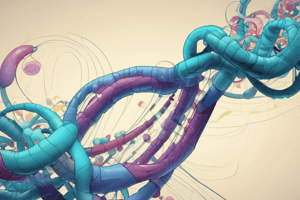Podcast
Questions and Answers
What is the role of the nucleus in an animal cell?
What is the role of the nucleus in an animal cell?
- Site of protein synthesis
- Site of energy production
- Site of DNA replication and transcription (correct)
- Site of waste elimination
How many nucleotides are present in the human genome?
How many nucleotides are present in the human genome?
- 32 billion
- 3.2 million
- 32 million
- 3.2 billion (correct)
What does the term 'autosomes' refer to in the context of the human genome?
What does the term 'autosomes' refer to in the context of the human genome?
- Non-sex chromosomes (correct)
- Cellular organelles
- Sex chromosomes
- Chromosomal DNA
Where is the circular chromosome found in human cells?
Where is the circular chromosome found in human cells?
What is the main function of the nuclear envelope?
What is the main function of the nuclear envelope?
What is the size range of the nucleus in an animal cell?
What is the size range of the nucleus in an animal cell?
What does the nucleolus in the nucleus of an animal cell produce?
What does the nucleolus in the nucleus of an animal cell produce?
Which molecule has a double helix structure and is mostly deoxyribose sugar?
Which molecule has a double helix structure and is mostly deoxyribose sugar?
What is the primary function of messenger RNA (mRNA) in the cell?
What is the primary function of messenger RNA (mRNA) in the cell?
Which molecule contains a complex tertiary structure, especially in transfer RNA (tRNA)?
Which molecule contains a complex tertiary structure, especially in transfer RNA (tRNA)?
What is the universal flow of genetic information as per the Central Dogma of Molecular Biology?
What is the universal flow of genetic information as per the Central Dogma of Molecular Biology?
Which of the following contains nucleosomes and various fiber sizes and carries genes?
Which of the following contains nucleosomes and various fiber sizes and carries genes?
What are the units of heredity that contain instructions for an organism's phenotype?
What are the units of heredity that contain instructions for an organism's phenotype?
What process creates mRNA from DNA in the cell?
What process creates mRNA from DNA in the cell?
Flashcards are hidden until you start studying
Study Notes
- Homologous chromosomes: maternal and paternal carry genes, have key structures like telomeres and centromeres, and differ in size and number of exons/introns.
- Chromosomes: made up of a double helix of DNA, nucleosomes, and various fiber sizes, carry genes.
- Genes: units of heredity, contain instructions for an organism's phenotype, are made up of exons and introns, and come in different sizes and numbers of exons/introns.
- Central Dogma: transcription creates mRNA from DNA, and translation produces proteins from mRNA, using different languages of nucleic acid.
- DNA and RNA: both nucleic acids, but DNA has deoxyribose sugar and double stranded structure, while RNA has ribose sugar and is mostly single stranded.
- DNA structure: composed of nitrogenous bases, deoxyribose sugar, and phosphate groups, forms base pairs through hydrogen bonding, and has specific ratios of bases.
- RNA: comes in various types, including messenger (mRNA), transfer (tRNA), ribosomal (rRNA), small nuclear (snRNA), small nucleolar (snoRNA), and small cytoplasmic (scRNA), and plays a role in protein synthesis and gene expression.
- DNA vs RNA: DNA forms a double helix and is mostly deoxyribose sugar, while RNA is mostly ribose sugar and is single stranded, except in some viruses.
- RNA structure: has a secondary structure with stems and loops, and a complex tertiary structure, especially in transfer RNA (tRNA).
- Central Dogma of Molecular Biology: genetic information flows from DNA to RNA to proteins, and the genetic code is universal to all organisms.
- Genome: the entire complement of DNA molecules in an organism, controls the generation of proteins and regulates metabolism and response to the environment.
Studying That Suits You
Use AI to generate personalized quizzes and flashcards to suit your learning preferences.



